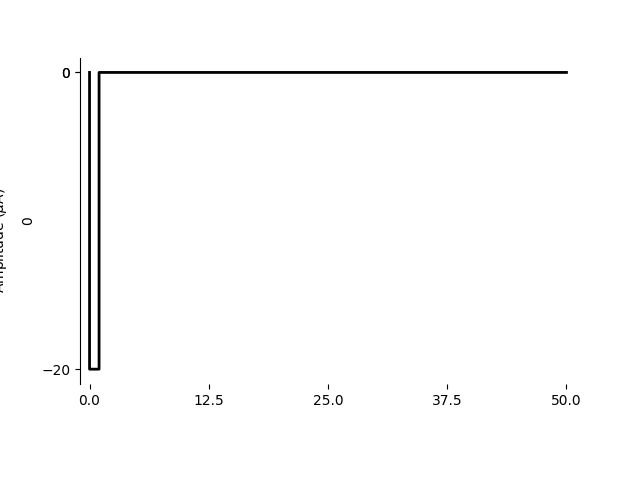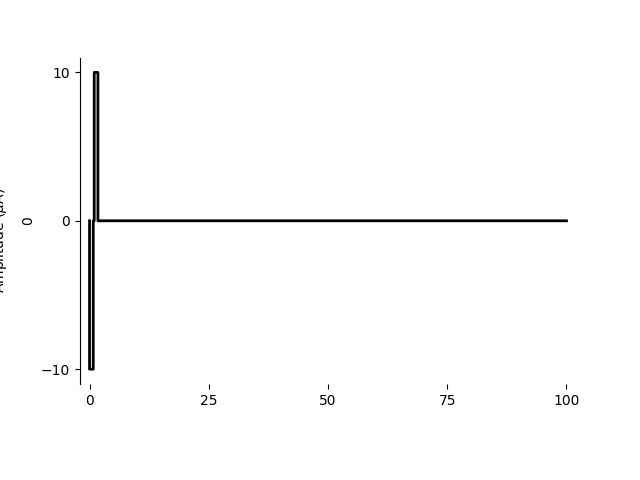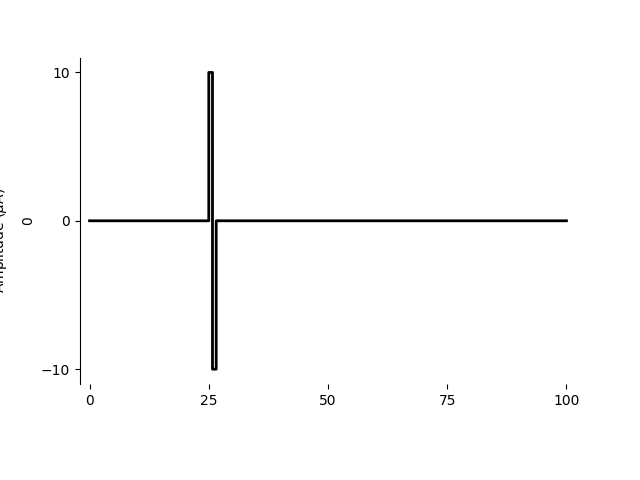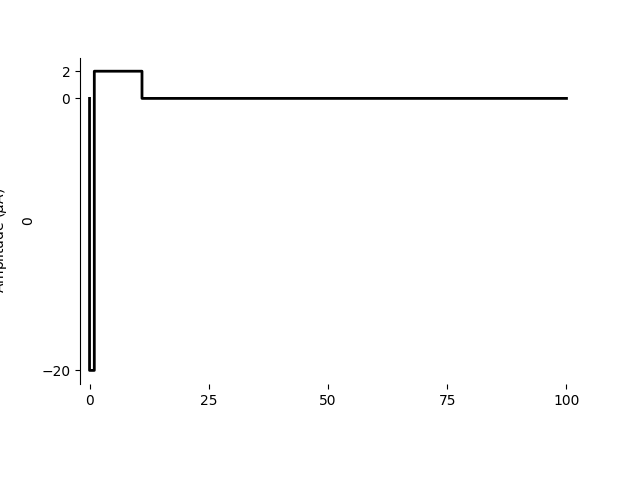Note
Click here to download the full example code
Generating monophasic and biphasic pulses¶
This example shows how to build and visualize monophasic and biphasic stimuli.
Important
Stimuli specify electrical currents in microamps (uA) and time in milliseconds (ms). When in doubt, check the docstring of the function you are trying to use.
A monophasic pulse¶
A MonophasicPulse has a single phase and can
be either anodic (by definition: has a positive current amplitude) or cathodic
(negative current amplitude).
Monophasic pulses require an amplitude (in uA) and a phase duration (in ms). You can also specify the total stimulus duration: zeros will be inserted after the pulse up to the desired duration:
from pulse2percept.stimuli import MonophasicPulse
mono = MonophasicPulse(-20, 1, stim_dur=50)
mono.plot()

Out:
<AxesSubplot:ylabel='0'>
Note
The sign of amp will determine whether the pulse is cathodic
(negative current) or anodic (positive current).
A (symmetric) biphasic pulse¶
A BiphasicPulse consists of a cathodic and
an anodic phase, optionally separated by an interphase gap.
Both cathodic and anodic phases will have the same duration (“symmetric”).
For example, to generate a cathodic-first biphasic pulse with phase duration 0.78 ms, separated by a 0.2 ms interphase gap, use the following:
from pulse2percept.stimuli import BiphasicPulse
biphasic = BiphasicPulse(10, 0.78, interphase_dur=0.2, stim_dur=100)
biphasic.plot()

Out:
<AxesSubplot:ylabel='0'>
Similarly, you can generate an anodic-first pulse delivered after an initial delay of 25 ms:
biphasic = BiphasicPulse(10, 0.78, delay_dur=25, stim_dur=100,
cathodic_first=False)
biphasic.plot()

Out:
<AxesSubplot:ylabel='0'>
A biphasic pulse is typically considered “charge-balanced” (i.e., its net current sums to zero over time):
Out:
True
Note
The sign of amp will be automatically adjusted depending on the
cathodic_first flag.
An asymmetric biphasic pulse¶
Analogously, an AsymmetricBiphasicPulse
consists of a cathodic and an anodic phase with different amplitude and
duration.
A common pulse consists of a short cathodic phase (e.g., -20 uA, 1 ms) followed by a long anodic phase (e.g., 4 uA, 5 ms):
from pulse2percept.stimuli import AsymmetricBiphasicPulse
asymmetric = AsymmetricBiphasicPulse(-20, 2, 1, 10, stim_dur=100)
asymmetric.plot()

Out:
<AxesSubplot:ylabel='0'>
When choosing amplitudes and durations accordingly, it is still possible to generate a charge-balanced pulse:
Out:
False
Multi-electrode stimuli¶
The easiest way to build a multi-electrode stimulus from a number of pulses
is to pass a dictionary to the Stimulus
object:
from pulse2percept.stimuli import Stimulus
stim = Stimulus({
'A1': MonophasicPulse(-20, 1, stim_dur=75),
'C7': AsymmetricBiphasicPulse(-20, 2, 1, 10, delay_dur=25, stim_dur=100)
})
stim.plot()

Out:
array([<AxesSubplot:ylabel='A1'>, <AxesSubplot:ylabel='C7'>], dtype=object)
Note how the different stimuli will be padded as necessary to bring all of them to a common stimulus duration.
Alternatively, you can also pass the stimuli as a list, in which case you might want to specify the electrode names in a list as well:
stim = Stimulus([MonophasicPulse(-20, 1, stim_dur=100),
AsymmetricBiphasicPulse(-20, 2, 1, 10, delay_dur=25,
stim_dur=100)],
electrodes=['A1', 'C7'])
stim.plot()

Out:
array([<AxesSubplot:ylabel='A1'>, <AxesSubplot:ylabel='C7'>], dtype=object)
Total running time of the script: ( 0 minutes 1.140 seconds)